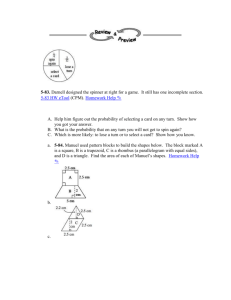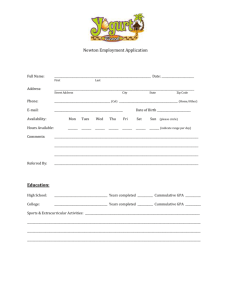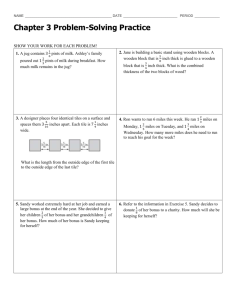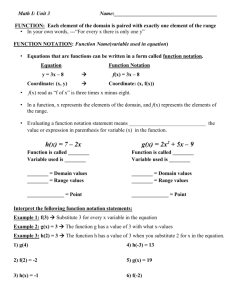Full text - ANNALS. FOOD SCIENCE and TECHNOLOGY
advertisement
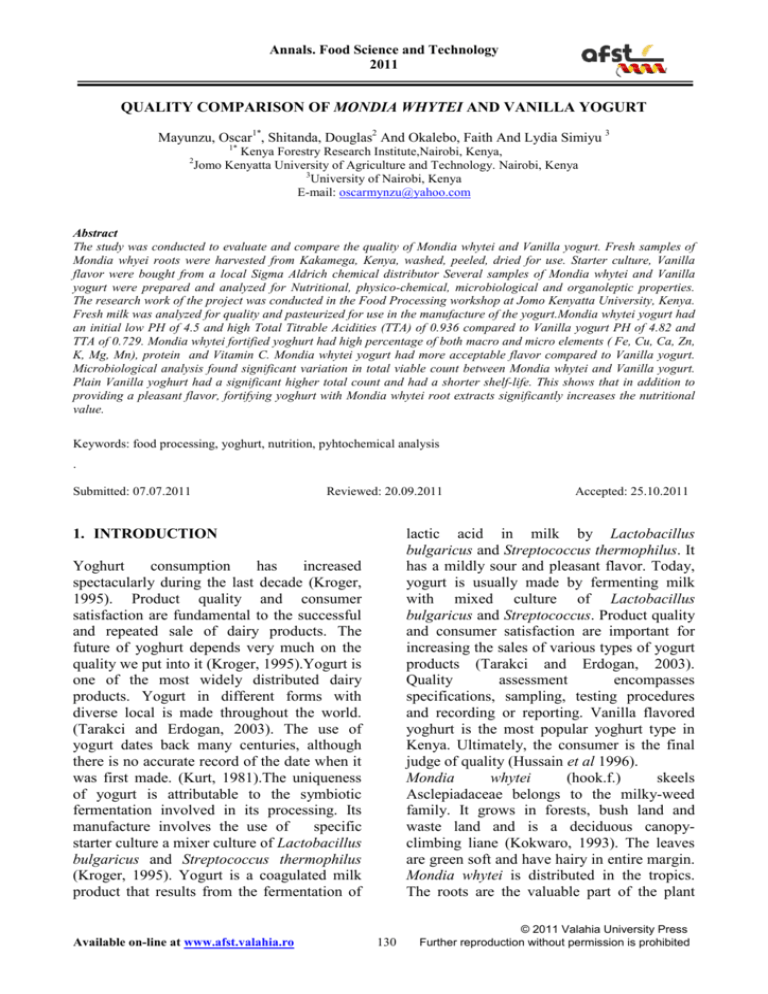
Annals. Food Science and Technology 2011 QUALITY COMPARISON OF MONDIA WHYTEI AND VANILLA YOGURT Mayunzu, Oscar1*, Shitanda, Douglas2 And Okalebo, Faith And Lydia Simiyu 3 1* 2 Kenya Forestry Research Institute,Nairobi, Kenya, Jomo Kenyatta University of Agriculture and Technology. Nairobi, Kenya 3 University of Nairobi, Kenya E-mail: oscarmynzu@yahoo.com Abstract The study was conducted to evaluate and compare the quality of Mondia whytei and Vanilla yogurt. Fresh samples of Mondia whyei roots were harvested from Kakamega, Kenya, washed, peeled, dried for use. Starter culture, Vanilla flavor were bought from a local Sigma Aldrich chemical distributor Several samples of Mondia whytei and Vanilla yogurt were prepared and analyzed for Nutritional, physico-chemical, microbiological and organoleptic properties. The research work of the project was conducted in the Food Processing workshop at Jomo Kenyatta University, Kenya. Fresh milk was analyzed for quality and pasteurized for use in the manufacture of the yogurt.Mondia whytei yogurt had an initial low PH of 4.5 and high Total Titrable Acidities (TTA) of 0.936 compared to Vanilla yogurt PH of 4.82 and TTA of 0.729. Mondia whytei fortified yoghurt had high percentage of both macro and micro elements ( Fe, Cu, Ca, Zn, K, Mg, Mn), protein and Vitamin C. Mondia whytei yogurt had more acceptable flavor compared to Vanilla yogurt. Microbiological analysis found significant variation in total viable count between Mondia whytei and Vanilla yogurt. Plain Vanilla yoghurt had a significant higher total count and had a shorter shelf-life. This shows that in addition to providing a pleasant flavor, fortifying yoghurt with Mondia whytei root extracts significantly increases the nutritional value. Keywords: food processing, yoghurt, nutrition, pyhtochemical analysis . Submitted: 07.07.2011 Reviewed: 20.09.2011 lactic acid in milk by Lactobacillus bulgaricus and Streptococcus thermophilus. It has a mildly sour and pleasant flavor. Today, yogurt is usually made by fermenting milk with mixed culture of Lactobacillus bulgaricus and Streptococcus. Product quality and consumer satisfaction are important for increasing the sales of various types of yogurt products (Tarakci and Erdogan, 2003). Quality assessment encompasses specifications, sampling, testing procedures and recording or reporting. Vanilla flavored yoghurt is the most popular yoghurt type in Kenya. Ultimately, the consumer is the final judge of quality (Hussain et al 1996). Mondia whytei (hook.f.) skeels Asclepiadaceae belongs to the milky-weed family. It grows in forests, bush land and waste land and is a deciduous canopyclimbing liane (Kokwaro, 1993). The leaves are green soft and have hairy in entire margin. Mondia whytei is distributed in the tropics. The roots are the valuable part of the plant 1. INTRODUCTION Yoghurt consumption has increased spectacularly during the last decade (Kroger, 1995). Product quality and consumer satisfaction are fundamental to the successful and repeated sale of dairy products. The future of yoghurt depends very much on the quality we put into it (Kroger, 1995).Yogurt is one of the most widely distributed dairy products. Yogurt in different forms with diverse local is made throughout the world. (Tarakci and Erdogan, 2003). The use of yogurt dates back many centuries, although there is no accurate record of the date when it was first made. (Kurt, 1981).The uniqueness of yogurt is attributable to the symbiotic fermentation involved in its processing. Its manufacture involves the use of specific starter culture a mixer culture of Lactobacillus bulgaricus and Streptococcus thermophilus (Kroger, 1995). Yogurt is a coagulated milk product that results from the fermentation of Available on-line at www.afst.valahia.ro Accepted: 25.10.2011 130 © 2011 Valahia University Press Further reproduction without permission is prohibited Annals. Food Science and Technology 2011 using spectrophotometric methods at JKUAT. The samples digested using the wet method for macro and micro- elements analysis using the Kjedhals digestion blocks). The standard stock and working solution for the elements analyzed were prepared using analar salts Shimadzu atomic absorption spectrophotometer and flame emission spectrophotometer (pyunicam) in JKUAT was used for analysis of both macro and microelements. and are eaten fresh or as a dried powder (Shitanda, 2007).The roots are boiled in porridge to treat stomach ache, stop vomiting as well as a flavoring agent and an appetizer. The roots are given to lactating mothers to enhance milk production (Mukonyi et al. 2004). Mondia whytei roots are also used to treat rheumatism, Gonorrhea and as an aphrodisiac (Kokwaro, 1993). It is also used to manage ringworms, heartburn, kidney complication, allergies, indigestion, Asthma, foot and mouth, disease and diabetes (Msonthi, 1991). Proteins Analysis for total protein content was performed using the combustion method. Nitrogen –carbon analyzer (sumigraph NC90A) coupled with a Shimadzu gas chromatograph. For total protein determination dried sample was combusted in stream of oxygen using the analyzer and the percentage nitrogen content determined. Percentage protein was computed for each sample by multiplying nitrogen content by a factor of 6.25. 2. MATERIALS AND METHODS The research work of the project was conducted in the Food Processing workshop at Jomo Kenyatta University. Fresh milk was analyzed for quality and pasteurized for use in the manufacture of the yogurt. Collection of samples Fresh samples of Mondia whyei roots were harvested from Kakamega, washed, peeled, dried for use. Starter culture, Vanilla flavor were bought from a local Sigma Aldrich chemical distributor. Microbiological analysis The microbiological analysis of Mondia whytei and Vanilla yogurt was carried out for total viable count as described by David and Fankhauser (2005). Product Analysis Total Titratable Acidity Acidity was measured by potentiometric method according to the BS 7142-5, 1997. Organoleptic evaluation All the samples of Mondia whytei and Vanilla yogurt were evaluated by ranking method for sensory characteristics and overall acceptability by sampling using questionnaires for ages (20 – 40) years of the population of Jomo Kenyatta University using the method described by BS 5929-6 (1989). PH The pH of Mondia whytei and vanilla yogurt was determined by using a Digital PH meter. The PH meter was standardized using PH 4.0 and pH 7.0 buffer solutions. PH was measured over several days. Statistical analysis The data was statistically analyzed according to John (1995a, b). Students’ T-test was applied to compare the samples of Mondia whytei and Vanilla as described by Daniel (2002). Significant differences were determined at (P= 0.05%). Total solid Total solids were determined by following formula, % Total solids (wt/wt) = wt. Of dry sample/ wt. of wet sample* 100 (Suzanne, 2003b) a) Nutritional Composition Qualitative and quantitative determination of macro and micro elements was performed Available on-line at www.afst.valahia.ro 131 Volume 12, Issue 2, 2011 Annals. Food Science and Technology 2011 The total solids content of Mondia whytei and vanilla yogurt is shown in Table 1. The average total solids content of Mondia whytei was 19.2 with a standard deviation of 0.006. While the average total solids content of vanilla yogurt was 17.75 of with a standard deviation of 0.035. These results are in line with findings of Muhammad et al. (2005) who reported the highest range of total solids in yogurt was 17.1%, but in case of Mondia whytei yogurt these results are significantly different. 3. RESULTS AND DISCUSSION Total titratible acidity The total tirtatable acidity of Mondia whytei and vanilla yogurt is shown in Fig 1. The average TTA of freshly prepared Mondia whytei yogurt was 0.936 percent with a standard deviation of 0.03. The average TTA acidity of Vanilla yogurt was 0.729 with a standard deviation of 0.01. These results are in line with findings Tarakci and Erdogan (2003) in which acidity increased over the storage period. Guler and Mutlu (2005). Figure 1 and 2 shows variation of TTA of Mondia whytei and vanilla yogurt with time. 6 PH The PH of Mondia whytei and vanilla yogurt is shown in Figure 1 and 2. In both cases, PH decreases during storage. The PH for fresh Mondia whytei yogurt was 4.5 compared with 4.82 for Vanilla yoghurt. These results are in line with findings of Varnam (1994) who reported yogurt PH as 4.50 – 4.90. Mondia whytei had a low PH than Vanilla yogurt, possibly due to the low total viable count of L. acidophilus bacteria. Nighswonger et al. (1996) also reported declining counts of L. acidophilus in yogurt over the storage period. 5 TTA, PH 4 Ph TTA Linear (Ph) Linear (TTA) 3 2 1 0 0 5 10 15 20 25 DAYS Figure 2. TTA, PH Curve for Vanilla yoghurt variation with time at room temperature Table 1: Physio-chemical analysis of fresh Mondia whytei and Vanilla yogurt Total Product TTA% PH Solids Quality Comparison of Mondia whytei and vanilla Yogurt 5 4.5 Mondia 0.936 4.5 19.2 Vanilla 0.729 4.82 17.75 4 3.5 Table2: Nutritional Analysis p H, TT A 3 Ph TTA Linear (Ph) 2.5 Sample Fe (ppm) Mondia Vanilla 138.62 32.80 Cu (ppm) Ca (ppm) Zn (ppm) K (ppm) Linear (TTA) 2 1.5 1 7.51 2.73 636.05 567.11 73.4 50.19 16040.23 12350.72 0.5 0 0 5 10 15 20 25 Day Sample Mg (ppm) Mn (ppm) Fat (%) Protein (%) Vitamin C(mg/1 0g) Figure 1. TTA, PH Curve for Mondia yoghurt variation with time at Room temperature MMMondia Vanilla Available on-line at www.afst.valahia.ro 132 190.44 18.02 2.05 3.19 32.92 164.9 3.57 1.45 2.1 32.9 Volume 12, Issue 2, 2011 Annals. Food Science and Technology 2011 a antioxidant and help in the control of stomach upsets. Microbiological analysis Total viable count The total viable count of Mondia whytei and vanilla yogurt is shown in Table 2. The average total viable count of Mondia whytei yogurt was 4.04 x 108 with a standard deviation of 0.93. The average total viable count of Vanilla ranged was 4.6 and standard deviation 1.22. These results are in line with findings of Lopez et al. (1997) who reported log aerobic mesophilic count from < 1.0-5.38 and from 4.87-6.67 per ml in natural yogurt. 5. ACKNOWLEDGMENTS The authors wish to thank the African Institute for Capacity Development (AICAD) for funding the project and the Kenya Forestry Research Institute and Jomo Kenyatta University of Agriculture and Technology for facilitating the study. 6. REFERENCES Table 3: Serial Dilution Analysis of Mondia whytei and Vanilla yoghurt Product Mondia Vanilla Total Viable Counts *104 *105 >80 47 >300 168 [1] Bourlioux, P. and P. Pochart, 1988. Nutritional and health properties of yogurt. World Rev. Nutr. Diet.,56: 217-58. [2] BS, 1741-5.2, 1990. Methods for chemical analysis ofliquid milk and cream. [3] BS, 7142-5, 1997. The methods for analysis of milk based products. [4] BS, 5929-6, 1989. Methods for sensory analysis of food.Part 6: Ranking. [5] Daniel, B., 2002. First steps in statistics. Sage Publications London, Pp: 71-73. [6] David, B. and Fankhauser 2005. Pour plate technique for bacterial enumeration. Unvi. Of Cincinnati Clermont College, Batavia OH 45103, pp: 1-3. [7] Debbie, L. Barnes, Steven, J. Harper, Floyd, W. Bodyfelt and M.R. McDaniel, 1991. Prediction of consumer measures of sweetness and sourness. Dairy Sci., 74: 37463754. [8] Hussain et al 1996 Quality Comparison of Probiotic and Natural Yogurt 12 [9] FAO, 1977. Lab. Manual F.A.O. Regional dairy Mutlu, B. Guler and A.M. Serdar Akin, 2005. Effects of development and training center for near east Philippines. [10] Guler, A. and B. Mutlu, 2005. The effects of different incubation temperatures on the acetaldehyde content and viable bacteria counts of bio-yogurt made from ewe’s milk. Int. J. Dairy Tech., 58: 174- 179. [11] John, 1995a. Statistics for food science. I. J. Nutr. And Sci. 4: 19-23. [12] John, 1995b. Statistics for food science. II J. Nutr. And Sci., 5: 29-34. *106 31 68 120 100 % P r e fe re n c e 80 20 - 30 30 - 40 40 - 50 60 40 20 0 Taste Flavor Color Smell Texture Would buy Characteristic Figure 3. Organoleptic evaluation 4. CONCLUSION The addition of Mondia whytei not only adds a pleasant flavor but also improves the shelflife and nutritional characteristics of yoghurt. Other beneficial health benefits include good Available on-line at www.afst.valahia.ro 133 Volume 12, Issue 2, 2011 Annals. Food Science and Technology 2011 [13] Kon, S.K., 1959. Milk and milk products in human nutrition. F.A.O. Nutr. Stud., 17. [14] Kroger, M., 1976. Quality of yogurt. J. Dairy Sci., Vol: 59: 344-350. [15] Kurtz, A., 1981. Sut. Teknolojisi. Ataturk Universitesi Yaymlari, No: 573 Ataturk Universitesi Basim Evi. [16] Lopez, M.C., L.M. Medina, M.G. Cordoba and R. Jordano, 1997. Evaluation of the microbiological quality of yogurt ice cream. Alimentaria, 35: 39-45. [17] Muhammad, B.F., M.M. Abubakar and E.O. Oyawoye, 2005. Effects of culture concentration and inoculation temperature on physicochemical, microbial and organoleptic properties of yogurt. Nig. Food J., 23: 156165. Available on-line at www.afst.valahia.ro [18] Msonthi, J. D (1991). A novel phenolic glycoside from roots of Mondia Whytei skeels. Bull Chem. Soc. Ethopia , 107 – 110. [19] Mukonyi, K.W, Lwande, W (2004). Phytochemical and Nutritional Values of Mondia Whytei. Paper presented at the 2nd Kenya Forestry Research Institute, Scientific Conference, November 2004, Kefri, Muguga [20] Shitanda, D., Mukonyi, K.W. and Wamalwa, L (2007). Characterization of Kenyan Grown Mondia whytei roots and their Potential Use. Paper presented at the International Agricultural Engineering Conference, Bankok, Thailand, 3-6 December, 2007. 134 Volume 12, Issue 2, 2011
